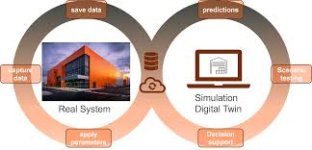A digital twin is a virtual replica of a physical object, system, or process. Think of it like a real-time simulation that mimics how a device, machine, or network behaves in the real world. While this concept was once mainly used in manufacturing and aerospace, IT companies are now using digital twins to develop smarter systems, test new software, and predict failures before they happen.
Here are some examples of how this advanced simulation model is being used by tech firms:
Large firms like IBM, Infosys, and HCL Tech have started integrating digital twin models into their software delivery and testing pipelines.
The adoption of digital twins is rising in IT for several reasons:
Imagine a digital twin of a company’s internal network. The IT team can simulate a new software rollout and see how it impacts server speed or security — without touching the real system. Bugs are found early, and downtime is minimized when the actual update goes live.
In another case, an AI-based monitoring system can be trained using synthetic data created by a digital twin of a customer behavior system, improving accuracy without needing sensitive real-world data.
Although promising, there are hurdles:
Despite these, IT companies are pushing forward due to the long-term ROI.
Digital twins in IT are still evolving, but they’re becoming more accessible thanks to cloud platforms and edge computing. As digital transformation continues, we can expect more widespread use of virtual testing environments — not just in hardware simulations, but also in cybersecurity, customer service, and product development.
Have you ever heard of digital twins being used in IT?
Do you think virtual simulations will replace traditional testing?
Drop your views or ask questions below
 How Are IT Companies Using It?
How Are IT Companies Using It?
Here are some examples of how this advanced simulation model is being used by tech firms:
- Testing networks and servers under simulated load conditions
- Creating digital replicas of cloud environments to monitor performance
- Predictive modeling for data centers to reduce downtime
- Running cybersecurity threat simulations in a safe virtual space
- Training AI models with synthetic data produced by the digital twin
Large firms like IBM, Infosys, and HCL Tech have started integrating digital twin models into their software delivery and testing pipelines.
 Why Digital Twins Are Gaining Popularity
Why Digital Twins Are Gaining Popularity
The adoption of digital twins is rising in IT for several reasons:
- They allow safe testing without breaking real systems
- They provide continuous feedback, helping teams improve performance
- They speed up product development cycles
- They reduce infrastructure costs by cutting physical trial-and-error testing
- They help in scenario planning for rare but possible events (e.g., server overload, data breaches)
 A Practical Example
A Practical Example
Imagine a digital twin of a company’s internal network. The IT team can simulate a new software rollout and see how it impacts server speed or security — without touching the real system. Bugs are found early, and downtime is minimized when the actual update goes live.
In another case, an AI-based monitoring system can be trained using synthetic data created by a digital twin of a customer behavior system, improving accuracy without needing sensitive real-world data.
 Challenges and Limitations
Challenges and Limitations
Although promising, there are hurdles:
- High initial setup cost for building a detailed digital twin
- Requires deep system understanding to build an accurate model
- May produce inaccurate results if not constantly updated
- Needs secure integration to avoid exposing company data during simulation
Despite these, IT companies are pushing forward due to the long-term ROI.
 The Road Ahead
The Road Ahead
Digital twins in IT are still evolving, but they’re becoming more accessible thanks to cloud platforms and edge computing. As digital transformation continues, we can expect more widespread use of virtual testing environments — not just in hardware simulations, but also in cybersecurity, customer service, and product development.
Have you ever heard of digital twins being used in IT?
Do you think virtual simulations will replace traditional testing?
Drop your views or ask questions below

